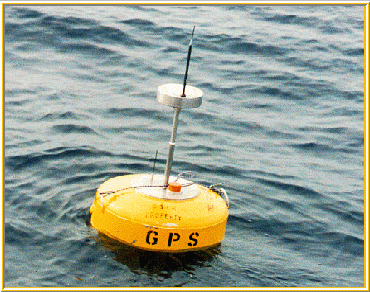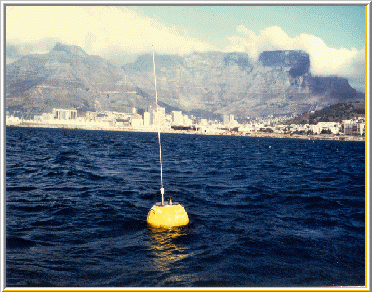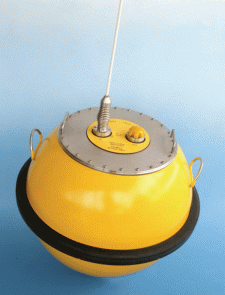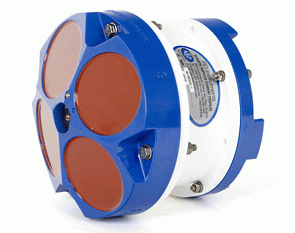
The advent of the differential
global positioning system (DGPS) on-the-fly (OTF)
and post-processing software has meant that physical
positions can be determined with an accuracy of less
than a decimeter. Post-processing for wave analysis
is acceptable because data have to be captured over a
17-minute period before any analysis can take place.
With these aspects in mind, the
CSIR performed tests with a GPS carrier-phase receiver
mounted on a wave buoy that was swung on a dynamic
calibrator. Vertical movement of the buoy, as
recorded from GPS was plotted against the actual
sinusoidal locus of the buoy. The recorded positions
were very accurate and within 2 centimetres of the
actual path of the buoy.
The accuracy of the direction in
which the the buoy was swinging was excellent. When
compared to existing directional wave systems, which
are accurate to within 10 degrees of direction, the
GPS has a clear advantage.
Provided a reference station can
be established within 30 kilometres of the wave buoy,
the differential GPS with OTF software proves to be
excellent technology for the measurement of ocean
waves (including wave directions) and tidal changes.

The Wavemonitor is a rugged, reliable wave measuring buoy
developed from experience gained from over 25 years of wave
measurement in the notoriously extreme ocean environment off
the southern African coast. It has been thoroughly tested and
satisfactorily compared to other commercially available wave
buoys.
Sea surface displacement with time is derived
from the displacement obtained through double-integrating the
vertical acceleration of the buoy. The buoy features an inertially
stabilised accelerometer transducer which is insensitive to either
horizontal or rotational movement. The wave data are transmitted
to a Wavelogger shore station by means of HF radio.
- Rugged design capable of withstanding severe spinning,
rolling and impacts
- Modular design with easy access to components through the
top cover for servicing and replacement
- Inexpensive battery replacement making use of alkaline cells,
which reduces servicing costs
- High measurement resolution and accuracy
- Compatible with other high frequency radio telemetry
systems
- Low current consumption providing long deployment intervals
between battery replacement
- SYSTEM:
- Wave height range: 20m
- Resolution: 9mm
- Frequency response: 0,04 to 5Hz
- Damping factor: 0,707
- Sensitivity to horizontal acceleration: < 2%
- Non-linearity and hysteresis: 1% of span
- MECHANICAL:
- Mass: 95kg
- Dimension: 720mm diameter sphere
- Hull material: Stainless steel 316
- BATTERIES:
- Battery life: > 7 months
- Quantity: 2 Packs per buoy
- Potential: 22V
- Pack configuration: 60 Alkaline "D" cells
- Capacity: 80Ah/buoy
Directional and non-directional Waverider

The CSIR makes use of Datawell's Directional Waverider
Mark II, Directional Waverider MKIII,
Directional Waverider DWR4, as well as
the non-directional Waverider SG buoys to measure waves.
Datawell has a history of over
40 years in the oceanographic instrumentation arena,
and their wave height measuring buoys have been the
world standard during this period. Their buoys are
accurate and have well-proven stabilized platform
sensors. They have, for example, standard integrated
data loggers, flash cards that store up to 2 Gbyte of
measured data, standard GPS position monitoring,
and a HF link for ranges up to 50 km.
For more detailed specifications
on each of the buoys, please consult the
Datawell website.
Accoustic Doppler Current Profiler (ADCP)

The CSIR makes use of ADCP's manufactured by Teledyne RD
Instruments. The 300 kHz Workhorse Monitor ADCP is
used for current measurements, and the 600kHz
Workhorse Monitor ADCP is used for both wave and current
measurments.
For more detailed specifications on the
ADCP's, please consult the
Teledyne RD Instruments
website.
Contact:
e-mail: Sarel Haasbroek
Snail-mail: CSIR, POBox 320, Stellenbosch 7599, South Africa
Telephone: International +27 21 888 2400 * National: 021 888 2400
Telefax: International +27 21 888 2693 * National: 021 888 2693
Page maintained by
Ursula von St Ange



